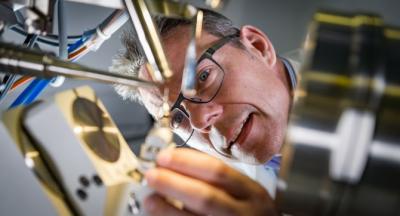However, when these largely single-use packaging materials enter the waste stream, those very properties also have a downside. That’s something that researchers led by teams at the University of Portsmouth and the US Department of Energy’s National Renewable Energy Laboratory (NREL) may have a new solution to.
A recent breakthrough came in the discovery of a unique bacterium, Ideonella sakaiensis 201-F6, which was found feeding on waste from an industrial PET recycling facility. The microbe had the ability to degrade PET and use it to provide carbon for energy. Central to this ability was the production of a PET-digesting enzyme, known as PETase.
According to the scientists the enzyme, which can digest PET and some of the other most commonly polluting plastics, could result in a recycling solution for millions of tonnes of plastic. Having been only recently discovered, Professor John McGeehan, Director of the Institute of Biological and Biomedical Sciences in the School of Biological Sciences at Portsmouth and Dr Gregg Beckham at NREL set about solving the crystal structure of the naturally occurring PET eating enzyme PETase, which is thought to have evolved in a waste recycling centre in Japan and allows a bacterium to degrade plastic as a food source.
The goal was to determine its structure and use the 3D information to understand how it works, but they ended up going a step further and accidentally engineered an enzyme which was even better at breaking down PET plastics.
“Although the improvement is modest, this unanticipated discovery suggests that there is room to further improve these enzymes, moving us closer to a recycling solution for the ever-growing mountain of discarded plastics,” says Professor McGeehan.
The researchers are now working on improving the enzyme further to allow it to be used industrially to break down plastics in a fraction of the time.
Diamonds Ring
In undertaking the research, the University of Portsmouth and NREL also collaborated with scientists at the Diamond Light Source in the UK, a synchrotron (a type of particle accelerator) that uses intense beams of X-rays.
Shaped like a huge ring, the facility works like a giant microscope by harnessing the power of electrons to produce bright light that scientists can use to study anything from fossils to jet engines to viruses and vaccines. Diamond accelerates electrons to near light speeds, producing a light 10 billion times brighter than the sun and powerful enough to see individual atoms when channelled into 31 laboratories known as ‘beamlines’. Using its latest laboratory, beamline I23, an ultra-high-resolution 3D model of the PETase enzyme was generated in exquisite detail.
“The long-wavelength macromolecular crystallography beamline I23 at Diamond is an incredibly advanced and unique facility that enables us to solve structures that are usually difficult to characterise,” explains Principal Beamline Scientist on I23, Dr Armin Wagner. “In the case of PETase, the protein crystals diffracted really well and we were able to achieve very high resolution. While most of the known protein structures have been determined to resolutions between 1.5 and 3.0 Å (0.15 – 0.3 nanometres), and we could achieve from for one [U1] of the investigated structures 0.92 Å. It basically makes what we are looking at much clearer and therefore easier to understand.
“The high-resolution 3D structure allowed us to get a clear picture of where the enzyme grips its target, which then informed the next step of computational modelling to investigate the mechanism of PET degradation further. The large, curved area detector in combination with the vacuum environment on the I23 beamline is ideal for this work as it allows high-resolution structure determinations at low X-ray doses limiting detrimental radiation damage effects to the crystals,” Wagner continues.
According to Professor McGeehan, being able to see the inner workings of this biological catalyst provided the blueprints to engineer a faster and more efficient enzyme.
“The detail that the team were able to draw out from the results achieved on the I23 beamline at Diamond will be invaluable in looking to tailor the enzyme for use in large-scale industrial recycling processes. The impact of such an innovative solution to plastic waste would be global,” says Professor Andrew Harrison, Chief Executive of the Diamond Light Source.
With help from the computational modelling scientists at the University of South Florida and the University of Campinas in Brazil, the team discovered that PETase looks very similar to another enzyme, cutinase, but it has some unusual features including a more open active site, able to accommodate man-made rather than natural polymers.
These differences indicate that PETase may have evolved in a PET-containing environment to enable the enzyme to degrade PET. To test that hypothesis, the researchers mutated the PETase active site to make it more like a cutinase.
Tales of the Unexpected
It was during these testing processes that the unexpected happened – the researchers found that the PETase mutant was better than the natural PETase at degrading PET. Significantly, the enzyme can also degrade polyethylene furandicarboxylate, or PEF, a bio-based substitute for PET plastics that is being hailed as a replacement for glass beer bottles.
“The engineering process is much the same as for enzymes currently being used in bio-washing detergents and in the manufacture of biofuels,” says Professor McGeehan. “The technology exists and it’s well within the possibility that in the coming years we will see an industrially viable process to turn PET and potentially other substrates like PEF, PLA, and PBS, back into their original building blocks so that they can be sustainably recycled.”
Dr Colin Miles, Head of Strategy for Industrial Biotechnology at BBSRC explains that: “This is a highly novel piece of science based on a detailed molecular-level understanding of an enzyme able to depolymerise a common type of plastic, whose persistence in the environment has become a global issue.”
The lead author of a paper covering the research and published in Proceedings of the National Academy of Sciences (PNAS), postgraduate student Harry Austin, concludes: “This research is just the beginning and there is much more to be done in this area.”





